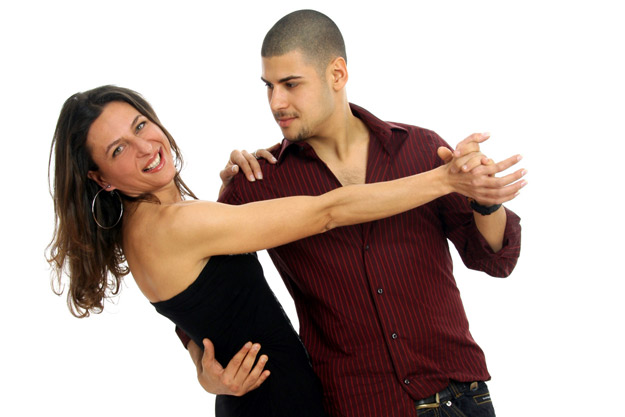Latin Dance Lessons
At Socialsport Dance Club we offer a wide array of possible dance styles for our students to learn, enjoy, and ultimately master!
Latin
Dance Lessons

Spice up the night every time you hit the dance floor by signing up for Latin dance lessons at Socialsport Dance Club! You and your dance partner will always be the hottest couple performing. With our staff, you’ll have the chance to learn the intricate movements and steps, as well as the origins, of a wide variety of Latin forms of dancing. From Huntingdon Valley and Willow Grove to Abington, Gwynedd, and Rydal, our talented instructors have developed the skills of Latin dancers throughout all of Montgomery County, Pennsylvania.
Below are the Latin dance lessons we offer to adult beginners at Socialsport:
Salsa is a sizzling, passionate style of dancing, which is why so many adult beginners want to learn how to move their bodies with such sensual excitement. This style has origins in Cuba, the original meeting point of African and European cultures. The basic steps of salsa consist of three weight changes in each four-beat measure.
The beat on which a dancer does not step generally consists of a tap or kick, or even a weight transfer. This helps them continue with the actual step, which doesn’t occur until the next beat. The dancer can either choose on their own which step to take, or take the one designed for the style of salsa being danced. In fact, one of the steps will be a “break step,” which involves a complete change of direction.
Bolero
As one of the five main competitive dances, the first step of bolero is usually taken on the first beat and held during the second beat, with two more steps included on beats three and four. When it comes to competitions, the music is in 4/4 tie and ranges anywhere between 96 and 104 bpm. This differs from other American Rhythm dances since it not only requires Cuban motion, but also rises similar to waltz and contra body movement.
Tango
Present day ballroom tango is separated into two categories: American Style nd International Style, both of which are enjoyed as social and competitive dances. Yet, the International version is the one that’s more globally accepted as the competitive style.
Although both styles consist of a closed dance position, the American style gives the dancers separation from a closed position, so they may perform open moves, such as alternate handholds, underarm turns, dancing apart and side-by-side choreography.
Argentine Tango
This is an interpretive, improvisational social dance meant to develop a strong connection between one another and the music, as well as the performers’ environment.
This style is thought to have developed in the late 19th century in the working-class neighborhoods of Buenos Aires, Montevideo, and Argentina, Uruguay; it was practiced by Uruguayan and Argentine musicians, dancers and immigrant laborers.
Mambo
Having originated in Cuba, the signature move of this style is a three-beat step moving forward, then backward while simultaneously shifting weight from one foot to the other; one of the dance partners performs the backward motion while the other moves forward.
What really separates the Mambo from other dancing styles is the hip-swaying action that occurs when the dancer shifts their weight. This initially started as a couple’s dance; however, the basic step has been involved in everything from aerobics videos to line dancing. Individual dancers perform the three-beat step either on their own or in a group.
Cha-Cha
This dance is performed to authentic Cuban music, Latin Pop or Latin Rock. While the music for the international ballroom Cha-Cha is lively and consists of a steady beat, the Cuban Cha-Cha is more sensual and usually consists of complex polyrhythms. Styles of Cha-Cha dances typically differ in the place of the chassee in the rhythmical structure.
Merengue
This style of dance involves a two-step beat, in which partners hold each other in a closed position. The leader holds the follower’s waist with their right hand, while also holding the follower’s right hand with their left hand, which is positioned at the follower’s eye level. The partners are able to move left and right by bending their knees slightly in both directions.
Over the course of the dance, the hips of both the leader and follower move in the same direction. Partners may either walk sideways or circle each other, using small steps. By switching to an open position, they can do separate turns without ever losing grip of their partner’s hands. While performing these turns, they may twist and tangle their handhold into intricate pretzels.
Hustle
The hustle refers to several disco dances that were extremely popular throughout the 1970s; nowadays, however, it’s mostly performed as a unique partner dance to disco music in nightclubs and ballrooms. Latin Hustle or New York Hustle are the terms generally used to refer to the couple form of this style.
In addition, the hustle closely mimics and involves steps similar to that of salsa. As with most other Latin dances, couples usually move within a “spot” on the dance floor, instead of following a line of dance, like foxtrot, or tracking within a slot, like West Coast Spring or LA Hustle.
Rumba
This is the slowest Latin style of dance among the five competitive International Latin dances: Samba, Cha-Cha, Paso Doble and Jive being the others. In Cuba, the ballroom rumba is also danced to a rhythm referred to as the bolero-son; the international version came from studies of dance in Cuba and during the pre-revolutionary period.
Ready to heat things up? Whether you’re in Huntingdon Valley, Willow Grove, Abington, Gwynedd or Rydal, we’ve got the best studio for salsa and other Latin dance lessons in Montgomery County, Pennsylvania. Register for adult beginner classes by filling out a contact form, or by calling 215-784-9087 to speak with us today!
